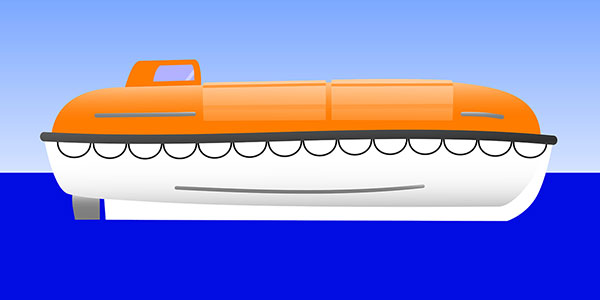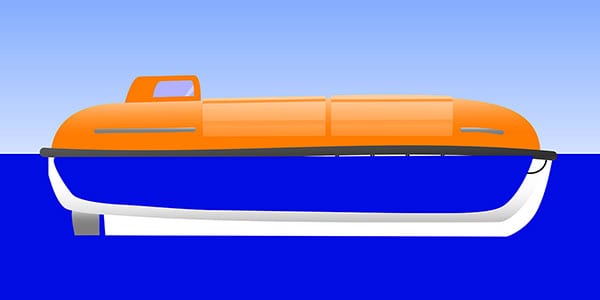Are Lifeboats Unsinkable?
Lifeboats are designed to keep passengers and crew safe in the unlikely event that their ship sinks. But, what about the lifeboat itself? Can a lifeboat sink, or are ship’s lifeboats actually unsinkable?
Lifeboats are not unsinkable, however, they will have sufficient inherent buoyancy to remain afloat even when they are completely flooded. Should that inherent buoyancy become damaged, however, there is the possibility that the lifeboat could sink.
In 1912, the “unsinkable” Titanic famously foundered on her maiden voyage. She had been designed with the best technology at the time to prevent her from sinking, yet she still went down.
The lesson we all learned was that the laws of physics mean that nothing is “unsinkable”.
It all comes down to buoyancy. As soon as you have insufficient buoyancy to remain afloat, any object will sink.
Lifeboats, as part of a ship’s safety equipment, are subject to a whole host of regulations that stem from the SOLAS (Safety of Life at Sea) convention and the LSA (Life Saving Appliances) code.
They are required to have enough reserve buoyancy to remain afloat, even in the unlikely event that they become completely swamped.
“Boats shall have inherent buoyancy or shall be fitted with inherently buoyant material which shall not be adversely affected by seawater, oil or oil products, sufficient to float the lifeboat with all its equipment on board when flooded and open to the sea. Additional inherently buoyant material, equal to 280 N of buoyant force per person, shall be provided for the number of persons the lifeboat is permitted to accommodate.”
SOLAS
This sort of situation may occur if it encounters a large, breaking wave for example.
To achieve the level of reserve buoyancy required, lifeboats employ a variety of techniques.
Sealed compartments which provide reserve buoyancy
Compartments within the boat may be sealed with airtight hatches, creating a number of “pockets” of air around the boat. As long as the sealed compartment remains undamaged, it will provide buoyancy to the rest of the boat should it flood.
The main disadvantage of these compartments is that they can only provide buoyancy when they remain completely sealed.
As soon as the compartment becomes damaged, it will no longer provide any reserve buoyancy. If, for example, the boat is involved in a collision, the watertight compartments could flood.
Ideally, you need a way of keeping water out of the compartment, even when it is damaged.
Compartments filled with expanding foam or polystyrene
You can evolve the concept of sealed compartments further by filling them with an inherently buoyant material. Commonly, expanding foam or polystyrene is used.
The idea is that if the compartment is damaged, there is no space left for water to enter, so the buoyancy is maintained.
You need to use a product that has a lot of buoyancy, meaning that it displaces a lot of water, yet remains very light itself.
Polystyrene and expanding foam both achieve this because they are filled with millions of small pockets of air.
What happens if a lifeboat gets flooded?
In normal circumstances, a lifeboat gets most of its buoyancy from the water displaced by its entire hull.

In a flooding situation, however, water enters the hull. There is less water displaced, so the boat sinks lower into the water.
The only buoyancy is now provided by parts of the hull that are still sealed.

The boat itself still remains afloat because there is enough “inherent buoyancy” provided around the edges of the boat by polystyrene and expanding foam.
Assuming the hull is intact, the occupants of the boat can use buckets, bailers and the bilge pump to remove the water that has entered.
Read more: What Is In A Lifeboat?
While it will be uncomfortable for the occupants, the lifeboat will remain floating and still provide protection.
Can a lifeboat capsize?
Theoretically, it is possible to capsize a lifeboat.
Lifeboats are designed to have positive stability, meaning that they want to remain floating up the right way.
As with every boat and ship, however, there is always a limit to their stability. If they lean over far enough, they will pass a “point of no return” where there is no longer enough stability remaining to return up the right way.
If they pass this point, they will capsize.
The inherent buoyancy in the boat will keep it floating, so it could still provide some protection from the sea.
What about self-righting lifeboats?
Some lifeboats are designed to be self-righting. This means that, even when they turn completely upside down, they will return the right way up.
Sometimes this is achieved with a permanent buoyancy chamber at the top of a mast. Lifeboats with cabins will often have a lot of buoyancy in the roof of the cabin for this purpose.
Other times, it may be through an inflatable tube that acts to flip the boat the correct way up if it ever turns over.
These “active” self-righting systems are more common on RIBs and rescue boats where you do not want a permanent buoyancy system mounted high up.
How safe are lifeboats?
In terms of flotation, lifeboats are very safe.
In the unlikely event that your lifeboat floods, it should still remain afloat, and provide you with protection from the elements.
The downside, however, is that the protection offered by a lifeboat is minimal in comparison to the ship it belongs to.
This is why you’ll often hear that the best lifeboat is the ship itself. Unless there is a real dire emergency that means the ship is dangerously unsafe, you should always prioritise staying on the vessel.
If you do find that you need to take to a lifeboat though, you can be assured that it is a comparatively safe place to be.
You have the inherent buoyancy provided by airtight spaces filled with expanding foam or polystyrene. If a large wave came and swamped the boat, you inherent buoyancy will keep the boat afloat so that you can bail out the additional water.
